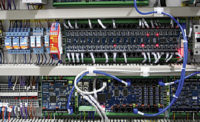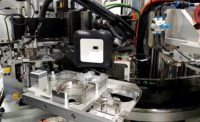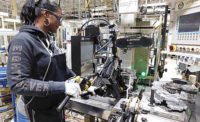Plant layout is always a factor when designing and installing a new assembly line. Transmission manufacturer ZF Friedrichshafen AG, based in Friedrichshafen, Germany, learned this valuable lesson in early 2013.
At that time, ZF production equipment engineers began designing a new U-shaped assembly line for assembling the company’s TraXon truck transmission with any of five modules: single- or dual-disc clutch, dual clutch, hybrid, motor-dependent power take-off and torque converter. Within a short time, however, the engineers realized that advanced automation technology was required for the line to fit within the plant’s modular production space.
“Our main requirements were ergonomic design according to the latest ergonomic findings, a consistent zero-fault strategy in the process and high output flexibility without productivity losses,” explains Rafael Kraja, assembly production planner at ZF. “In addition, the utilization rate was to be above 90 percent and plant availability above 96 percent.”
After consulting with conveyor drive manufacturer Kirchner Solutions GmbH and its electronic partner Graf Automation GmbH, ZF engineers decided that several Siemens AG products were the best automation technology for the assembly line.
The line consists of 34 interlinked workstations, as well as preassembly and commissioning areas. Cycle time can be adjusted to between two and eight minutes, depending on customer requirements. Two transmission series are assembled in 500 different parts-list variations. Individual transmissions can be made to order.
Each transmission is automatically brought on a trolley to the workstation and oriented in the best position for ergonomic assembly. Each trolley is connected to a common emergency stop cycle and controlled by a Siemens Simatic ET 200S system. Additional ET 200S systems control the workstation equipment and picking shelves. A Simatic S7-317 PN processor controls the assembly line.
Communication to the trolleys takes place wirelessly via Profinet. A radiating cable that serves as an antenna is located in the support rails. Workstation PLCs are connected via Industrial Ethernet cables, and each workstation features a Simatic flat-panel monitor that displays each assembly step in detail. Web browsers on the PCs can be used to perform diagnostics. CPU data is displayed on each monitor.
ZF engineers also use Siemens’ TIA Portal to integrate all controllers, I/Os, HMIs, drives, motion control and motor management into a single engineering environment. The portal’s Simatic Step 7 software enables ZF operators to easily configure, program, test and diagnose all Simatic controllers.
Ralf Klews, a production equipment designer in the electrical engineering department at ZF, estimates the new assembly line reduces production life cycle costs by about 30 percent due to reduced engineering, faster machine installation and less machine downtime.
“The new line is a consistent expansion of [our] proven production system principles, such as just-in-time manufacturing, standardization, flexibility and employee focus,” concludes Günther Stauber, project and assembly manager at ZF.
ZF operates 121 production facilities in 27 countries and employs 71,500 people. Last year it acquired American auto parts manufacturer TRW Automotive for $13.5 billion.
For more information on processors, portals and other automation technology, call 800-743-6367 or visit www.usa.siemens.com.





